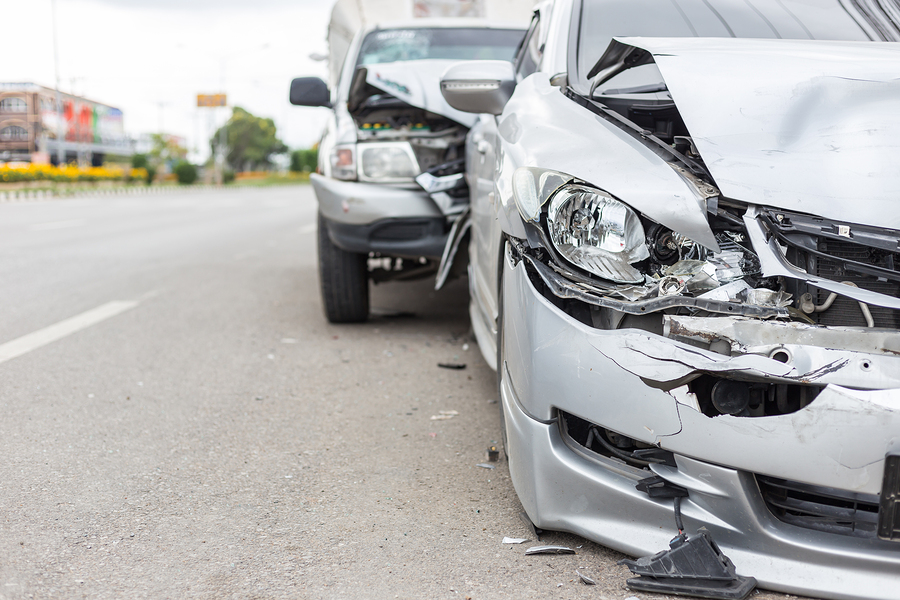Car accidents are all too common on Virginia’s highways and roads. In 2018, 819 people were killed in car crashes in the state, while 66,523 people were injured. What type of car accidents cause these injuries and fatalities? All kinds. Cars hit other vehicles, objects such as debris on the road, pedestrians, and trains. Cars run off the road into ditches and culverts. Nearly every type of accident can cause injuries and fatalities, in Virginia and everywhere else. Here is a brief review of the most common type of car accidents.
Collisions With Another Vehicle
The overall category of collision with another vehicle is responsible for 38 percent of all accidental traffic deaths in the U.S., according to the Insurance Information Institute. The most common area on the vehicle for collisions to occur is what reports term an “angle” crash, which causes nearly 18 percent of all collision-related deaths. An angle is a car crash that is not a head-on, rear-end, or side-swipe accident, in other words. The type of accident referred to as a T-bone, or broadside accident, in which a car is hit in the middle by another vehicle, is a subcategory of angle crashes.
Head-on accidents cause roughly 10 percent of vehicle collision-related deaths. Head-on accidents can be extremely serious, largely because they result from some type of misjudgment, such as a driver trying to pass on a two-lane road without sufficient space or time to complete the passing maneuver or entering the roadway going the wrong way. Head-on collisions can occur when a car tries to enter or exit freeways or roads the wrong way. Because of the misjudgment, the cars may be going at high speeds when the accident occurs, which can exacerbate the impact.
Rear-end collisions cause nearly 7 percent of all vehicle collision-related fatalities. While that indicates that rear-end collisions are certainly often serious, rear-end collisions are also one of the most common car accidents, and can also be fender-benders in which property receives minor damage, but no one is seriously hurt.
Rear-end collisions are almost always the fault of the driver who rear ends. Why? Because all drivers should take care to leave sufficient space between themselves and the car in front of them. It’s part of defensive driving, and enables the driver behind to stop in time in case the driver in front stops very suddenly.
Sideswipe vehicle crashes cause 2.7 percent of vehicle collision-related fatalities. A sideswipe can occur when one vehicle moves into an adjacent lane, and another vehicle is already there. They can also occur in passing, if the driver in the passing vehicle doesn’t leave sufficient space or doesn’t realize a vehicle is there. In a sideswipe, one vehicle moves against the side of the other.
Sideswipes can be especially dangerous because the impact can throw the other vehicle into another lane or off the road. In other words, it can be the precipitating event to an even more dangerous collision.
Collisions With Fixed Objects
Not all accidents are vehicle-on-vehicle, however. Many car crashes occur when the car hits a fixed object. These crashes cause more than 30 percent of car crash deaths nationwide. Collisions with fixed objects often occur when a car has swerved off the road or is in the process of doing so. The two most common fixed objects in these crashes are shrubbery/trees, which are responsible for 7.5 percent of fatalities in this category, and culverts/ditches/curbs, which are responsible for 7.3 percent of fatalities in the category.
What causes drivers to hit trees and curbs? The reasons are many, and varied. Some of these accidents may occur secondarily to a collision with another vehicle that knocked one vehicle off the road. A driver going too fast may lose control of the car on a turn, and slide into these objects from the road.
Being impaired with alcohol or drugs can affect reflexes and judgment enough so that drivers can lose control of their cars as well. Approximately 29 percent of all accidents in Virginia involve drivers whose blood alcohol content (BAC) is 0.08 or above, the legal threshold for a driving under the influence (DUI) charge, a figure roughly in line with the national average, according to the National Highway Traffic Safety Administration (NHTSA). While not all DUI-related crashes involve collisions with stationary objects, of course, it’s worth noting that the impairments involved in driving while drunk can definitely cause such accidents.
Some collisions with fixed objects may occur as a result of a sudden medical emergency on the part of the driver, such as a heart attack rendering them unconscious.
Fatigued or drowsy drivers can actually fall asleep at the wheel and, as a result, veer off the road. In one study, one in 25 drivers said they had fallen asleep while driving over the last 30 days. Drowsy driving causes an estimated 72,000 crashes, 44,000 injuries, and 800 fatalities per year, according to the U.S. Centers for Disease Control and Prevention (CDC).
An additional 22.6 percent of accidents in this category are caused by cars hitting an object that is not fixed. What kind of non-fixed objects are hit? Unfortunately, the largest percentage of crashes in this category are caused by hitting pedestrians, at 16 percent. More than 5,500 pedestrians are killed each year by vehicles.
The second largest category was pedal cyclists. Collisions between cars and pedal cyclists caused 2.4 percent of deaths in this category, with more than 800 pedal cyclists being killed.
Cars also hit animals and trains in this category, and they cause 0.5 percent and 0.3 percent of deaths, respectively.
Rollovers
Approximately 9 percent of all motor vehicle crash deaths are called by a type of accident called a rollover. Rollovers occur when a car tips and rolls over, either onto its side or over entirely. They are more common in vehicles with a high center of gravity, such as SUVs. Rollovers can be caused by multiple factors. An accident which delivers a glancing blow to a car may be sufficient to tip it or start to tip it. Being knocked off a road, especially into a downward incline, can exacerbate a vehicle’s tendency to tip over. Rollovers can also be caused by driving on highly uneven pavement or even hitting exceptionally deep potholes.
Finally, they can be caused by car equipment failures. A worn or bald tire that blows out, for example, can precipitate a rollover.
If you have additional questions or require legal assistance with a car accident, contact an experienced Virginia car accident lawyer today.


